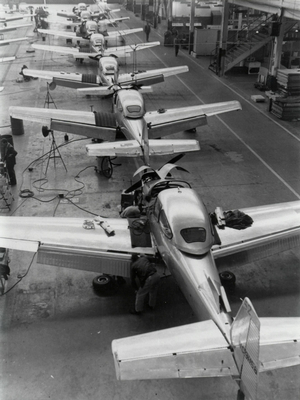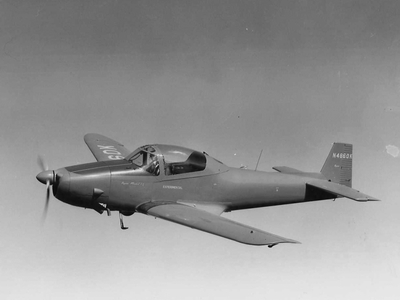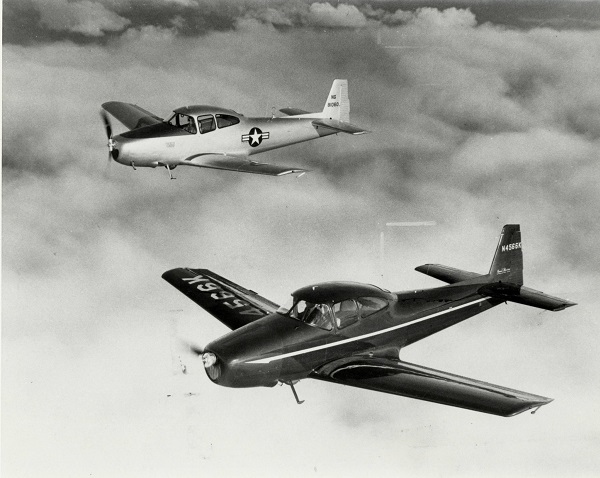
The home of everything related to Twin Navion and Camair aircraft

- Home
- News
- Navion History
- Types of Navions
- Individual Aircraft Histories
- Database
- Stories
- Maintenance Resources
- Manufacturer's Brochures
- Publications
- Models
- Toys
- Collector Cards
- Flight Simulation
- Marketplace
- Links
The post-war period of the 1940s was a booming time for general aviation. Although sales would prove to be substantially lower than
the aircraft manufacturers had expected, the light plane market was still populated with new designs. Some of the first to reappear
after the war were variations on pre-war designs; the Aeronca Chief and Piper Cub being the most famous. Others, like the Aeronca
Champ and Stinson 108, used the tried and true construction method of a welded steel-tube fuselage, wooden wings and fabric
covering.
With the war came a universal acceptance of semi-monocoque aluminum airplanes, a durable construction method honed to perfection
through years of wartime production. Several of the larger American manufacturers chose to continue with this construction method as
they introduced light planes. Globe offered the Swift, Republic sold the amphibious RC-3 SeaBee, Cessna the 190/195, Beech the Model
35 Bonanza and North American Aviation their NAvion.
Towards the end of the war most aircraft manufacturers began reducing their employee base, a move adopted by North American
Aviation. But executives at North American knew that the jet engine has rendered propeller driven warplanes obsolete, and expected
the American military to announce contracts for new jet-powered fighters and bombers. Lee Atwood (President of NAA) and others
proposed keeping a core group of skilled employees together. In the meantime, they could work on developing a four-seat business
plane. Between the last P-51 Mustang and the first of the F-86 Sabre, the NAvion would help keep North American's Los Angeles,
California factory operating.
As one would expect (since North American had no general aviation experience) the design team drew heavily from their military
background. Heavy skins covered a sturdy airframe, supported by tall and robust landing gear legs. The wing utilized a technique
known as a 'bullet proof structure' in which there is no full-span wing spar. Instead a stub-spar carried the loads from the main
landing gear inwards, while numerous stringers carried the loads from the outer wings. Like the famous P-51D fighter, the NAvion
incorporated a sliding canopy. Not surprisingly many people began calling the NAvion the every man's Mustang, and this would have
been even more pronounced had the original concept of a tail dragger come to pass.
A prototype was built and quickly drew attention from across North America. One customer, who bought his Navion sight-unseen,
quipped, "If North American built it - I'll buy it." Businessmen, movie stars and farmers all lined up to buy Navions of their own.
Not surprisingly the US military also showed an interest. Both the Air Force and Army were in need of smaller general transport
types, and the NAvion, with its passenger comforts, rugged construction and North American heritage impressed the generals. In 1947
the USAF placed an order for 83 NAvions under the designation of L-17A.
In late 1948 North American began receiving contracts for its jet aircraft; the F-86 Sabre and B-45 Tornado. Needing to reopen
military production lines and facing marginal profits, North American sold the Navion rights to the Ryan Aeronautical Company for
$8-million. Production moved to San Diego, California and restarted.
By 1949 Ryan began introducing changes to improve the Navion (the capitalization of the 'A' was dropped as it was an abbreviation of
North American). Auxiliary fuel tanks, improved instrumentation were popular options, as were the colorful paint schemes.

A view of the Navion's production line in the Ryan factory.
Photo courtesy of Ryan Aeronautical Co.
For years the biggest challenge facing Ryan was the lack of performance caused by its meager 205hp engine. In 1951 Ryan introduced
the Super 260, the ultimate Navion, with a 260hp geared Lycoming engine, deluxe interior and fancy paint. Suddenly there was a need
to redesignate the Navion; 205hp models from NAA and Ryan suddenly became Navion As, while the Super 260 became the Navion B. An
experimental version, called the Model 72, was built to compete in the USAF's primary trainer competition, which it lost to the Beech
Mentor. Had it won, it would have become the T-34.

The Model 72 during its US Navy evaluation period.
Photo courtesy of Ryan Aeronautical Co.
Even though Ryan's order books were full, Ryan had to face an undeniable truth - they lost money on every Navion they built. Each
plane cost about $15,000 to make, and basic models were selling for as little as $9,500. At the end of 1952 Ryan ceased all Navion
production. A total of 2,350 had been completed (1 prototype, 1,109 by NAA and 1,240 by Ryan).
While the Navion was still in production, the USAF returned (in 1948) to place another order, this time for 163 upgraded L-17Bs. A
further 35 L-17As returned to the factory for the same upgrades, becoming L-17Cs. In 1952 the USAF deployed L-17s to the Orient in
the first wave of the Korean War. The first L-17s actually took off from the aircraft carriers USS Sicily and USS Badoeng Strait.
Once in Korea L-17 pilots, with their RCA radios, were able to relay communications from the common foot soldier to the warplanes of
the USAF and USN. In many cases these were requests for air strikes - giving birth to Forward Air Control (FAC). Several reports
were even made of Communist soldiers confusing L-17s with the similar looking F-51D Mustang and either sought cover from passing
Navions or surrendered to the unarmed planes.

A Navion A and L-17B fly together in this Ryan promotional photo.
Photo courtesy of Ryan Aeronautical Co.
In 1957 the type certificate was sold to the Navion Aircraft Co., a division of Galveston, Texas based Tubular Service Engineering
Company (TUSCO). They started by taking a small number of existing Navions and modifying them with speed fairings, flush windows,
34 US-gallons Fletcher tip tanks, flush riveted wings, a baggage door, and Continental O-470 engines (of three different power
ratings) to create Navion D, E or Fs. Because the D and E had less than 260hp neither required the structural 'beef-up' kit that
was installed in the Navion B and F. A dozen Ds were converted, only 3 Es, and nearly three dozen Fs.
In 1960 TUSCO modified a Navion using all the upgrades from the Navion F, but performed a major modification to the fuselage. The
signature sliding canopy was replaced with a conventional fuselage with a car-like entry door. Named Rangemaster, the Navion G
certainly lived up to its name, stretching the Navion's range from 500 to 1,800 miles. A final version, the Navion H, featured a
285hp Continental IO-520-B. 100 of these G and H models were built by TUSCO. In 1965 production passed to the Navion Aircraft
Corporation and a small number of Rangemasters were assembled from parts.
Rights to the Navion continued to pass through six private and small corporate owners before being purchased by Navion Aircraft
Company Ltd. in 2001. These were the last owners hoping to reintroduce a modernized Navion into full-scale production. The undeniable
fact was Navions are expensive planes to build and the general aviation market had passed the Navion by.
Through the 1960s and right up to today, Navion owners have busied themselves with uncountable modifications, each designed to
increase speed, improve usability, or to incorporate the newest in technology. Some modifications were simple, such as the
replacement of the multi-piece, rubber sealed windows with flush mounted or single piece examples. The popular Palo-alto conversion
for the horizontal stabilizer was good for a couple miles per hour increase in speed, and fiberglass and metal fairings have done
their part too. Besides the common 225, 240, 250, 260 and 285hp engine conversions, many ambitious Navion owners have installed a
variety of engines, reaching as high as a 540shp Walter turbine. Lately the change has been towards incorporating modern 'glass'
instruments into an ergonomic instrument panel.
Currently the Navion type certificate is in the possession of Navion Aircraft International, part of Sierra Hotel Aero, Inc. of St.
Paul, MN. Their goal is to remanufacture all models of Navions, incorporating their own modifications. NAI debuted their 'new'
Rangemaster with a turbo-charged engine and all new avionics in early 2006.